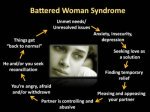GOODFINDING ebook Now On Sale for $.99!
Nonverbal Communication Skills
For Improving Your Connection In All Relationships
Authored by William G. DeFoore, Ph.D.


What you do--your nonverbal communication--is more important than what you say! Communication studies show that a whopping 93% of the message communicated is nonverbal, so let's make sure you're sending the message you want to!
Very important precautions:
- Don't even try this if you're angry. You won't be able to use your nonverbal communication skills for teen anger management unless you are calm yourself. Need help getting calm? Use our anger management techniques first, then work on helping your teen.
- In order to know which of these nonverbal communication skills to use when, just trust your own gut feeling or parental instinct. Read the signals coming from the teen, and use your own best judgment as to what you need to do.

Basic Nonverbal Communication Skills

1. Facial expression is very important. A relaxed, concerned expression is usually the best for conflict resolution. When you frown or look angry yourself, you're just feeding the problem. It's probably not good to smile too much, because this might make your teen think you're not taking them seriously. Try matching the teen's facial expression a little bit, then adding your own relaxed, concerned look. This form of nonverbal communication lets them know you're connected and you care.
2. Your orientation--the way you're facing is a lot more important than you might think. Your choices of orientation are either face to face or side by side. If you're face to face, try to get on the teen's eye-level so you're not looking down on them--or up to them, if they're taller than you! Side by side orientation means just sitting or standing by their side, maybe with your arm around their shoulder if it feels like that would help. Let's look at the pluses and minuses of these two different orientations:
Face to face is good because:
- You can easily have eye contact. Eye contact is sometimes absolutely necessary and sometimes not. Use your gut feeling to decide.
- You can read each other's nonverbal communication signals better if you're face to face. These signals help you know how to respond so your teen knows you care and want to help.
- Face to face is more of an authoritative stance, which may or may not be what you're wanting to communicate, according to the situation and the needs of the teen. If you're feeling strong and confident as you face them, it lets the adolescent know you're in charge of the situation. As a general rule, it is essential that you send the message that you're in charge. Teens are still minors, and they're not ready to be in charge of adults or even completely in charge of themselves. If you give them too much power, it hurts them and that hurts you too. If you don't give them enough power, that is harmful in a different way. Good parenting is a major balancing act, and I think you're up to the challenge! Get counseling or coaching help with your nonverbal communication and parenting skills here.
Side by side is good because:
- It gives the message, "We're both going in the same direction. We're in this together. I can see your viewpoint and I understand."

- This is especially good if the teen is very upset and becoming aggressive. Side by side is less confrontive than face to face, and again it gives the nonverbal communication message that you're connected with them on their journey to conflict resolution.
- The side by side orientation also gives you the chance to touch the adolescent in an innocuous, non-threatening way. At the very least, you can have a slight shoulder-to-shoulder contact, and if you feel it is appropriate, you can put your arm around the teen in a relaxed, easy manner.
3, Proximity, or how close you are, can make a huge difference in the comfort level of the teen in nonverbal communication. Read their body language and facial expression to find the right amount of closeness or distance. You can make subtle adjustments in this by leaning back and leaning forward, if you're sitting close by.
You really have to be clear within yourself to master nonverbal communication--for example, sometimes leaning toward the teen will show interest and concern, while other times it will feel too pushy or too needy. Tricky business for anybody, but if you have a lot of emotional issues of your own, it's virtually impossible. You might want to listen to this program to learn more about being personally clear and resolving your own emotional issues.
4. The power of your touch cannot be overstated here. This is, of course, a very "touchy" subject, in every meaning of the word. There are safest forms of touch, and then other forms that are a little more risky that should be used with a lot of forethought and care. There are so many ways that you as an adult can unconsciously violate the emotional and/or sexual boundaries of adolescents--and the best way to avoid that is to focus on safe and appropriate forms of touch. Let's look at some of these different kinds of touch:
Safest forms of touch, that can be used pretty comfortably with both genders, all ages, and in almost any situation:

- Handshakes. The good old reliable handshake is worth its weight in gold, because no one is likely to misinterpret it in any way. I encourage you to use the handshake frequently and confidently, when the relationship seems too new or uncertain for any other kind of contact. This form of nonverbal communication with an angry teen sends a powerful message of, "I'm here, I see you, and I am available." It is almost always better than no touch at all!
- Placing your hand on the arm or shoulder of the teen is usually pretty safe too. This is usually done on greeting or parting ways, as a kind of friendly nonverbal "hello" or "goodbye." It's important that you not leave your hand there too long--just a few seconds will do the trick. You may be aware of the research that shows that waiters who appropriately touch their customers get better tips, and library visitors that were lightly touched by the person checking them out gave the library a higher rating than those who were not touched. Secretly, we are all yearning for contact and connection with each other, whether we know it or not.
Other forms of touch that require more of a comfort level and a closer relationship would include:
- Putting your arm around the shoulder of the teen is generally safe, if they are your child, or if you feel a close and relaxed relationship. Depending on the nonverbal communication you get from the teen when you do this, you may want to remove your arm fairly quickly, or it may be appropriate to leave it there for a while. If you find that your judgment about closeness and appropriate touch is impaired and you tend to misjudge these types of boundaries, please seek professional counseling to improve your own emotional health.
- Putting your hand on the knee or just above the knee is only appropriate if the teen is your son or daughter, and of the same gender as you.
Hugs are certainly an appropriate and wonderful form of touch between an adult and a teen, with some important considerations.

- One question is, who initiates the hug? Chances are, many teens won't initiate hugs but really need them. This is where your good judgment comes in again. However, please keep this in mind: is the hug for you, or the teen? If it's for you, it's best to keep it to yourself. Unwanted hugs can do more harm than good, especially if the teen senses that it's all about your needs and not theirs. Read the nonverbal communication coming from the teen, and trust your good heart to tell you the best move.
- Another hug consideration is, how long does it last? If the teen is physically trying to get out of the hug, let them go immediately! If you feel the teen relaxing into the hug, and especially if he/she breathes a sigh, then hold the hug a little longer. In the best case, the teen may start to cry, which is an excellent response indicating that they are comfortable enough with you to release some stored up emotion.
- One of the most important things to be aware of when hugging a teen is any kind of sexual contact or sexual feeling. If you are aware of any sexual feelings while hugging a teen, stop hugging immediately! I assure you, they will pick up on your feelings, and it will feel like a violation to them, and therefore it will be a violation. Keep your pelvis back, and that way you'll be sure there is no contact below the waste. Of course any face to face hug is going to include breast contact, but be sensitive to the teen you're hugging. If you're aware of any sexual confusion on their part, or if you sense that they are inhibited about their sexuality, or if you sense they have a sexual attraction to you, you may want to avoid face to face hugs entirely. A hug from the side would be a preferable form of nonverbal communication in these cases.
- Kissing on the lips is generally not a good idea with adolescents. Lip kissing is too intimate for some teens, and could create some confusion that could interfere with their emotional and sexual development into adulthood. For example, you kiss your child on the lips when they are children--so if that continues into their adolescence, it may keep them feeling like a child in your relationship. You want to encourage their development into adulthood, and not interfere in any way.
5. Gestures are very powerful forms of nonverbal communication, and can work for you or against you in helping teens with anger control. Rapid, aggressive movements will certainly aggravate your teen's anger, and certain hand gestures will set them off for sure. Making a fist, for example, is always perceived as an aggressive form of nonverbal communication.
Leaning toward the teen while face to face during a confrontation can also aggravate the situation. Remember, you want to make things better, not worse. We would need a video to give a full description of all of the positive and negative gestures, so for now let's just say your primary goal is to show respect for the teen, while also maintaining your authority as teacher, parent, counselor, or supervisors.
Still looking for more? Here's another great resource for nonverbal communication.

- Home
- Contact Us
- Nonverbal Communication
We receive commissions on Amazon sales on this website.





New! Comments
Have your say about what you just read! Leave me a comment in the box below.